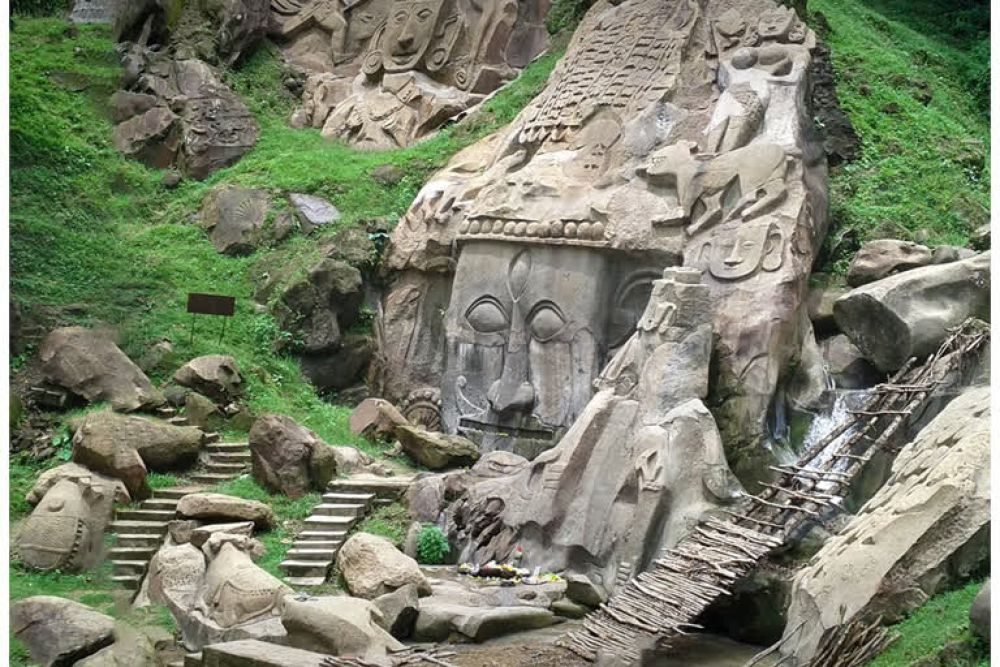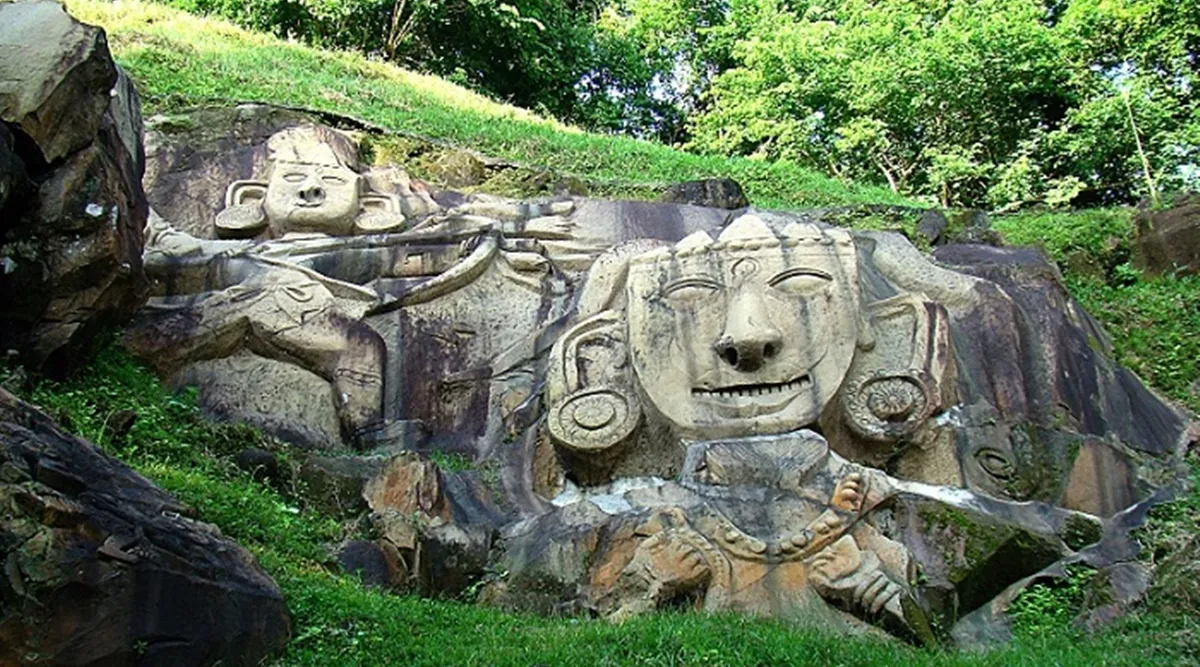Unakoti, located in the northeastern state of Tripura in India, is often referred to as the “Angkor Wat of Northeast.” This archaeological marvel, carved into the rugged hills of lush forests, holds immense historical and spiritual significance.
This ancient Shaivite place is known for its massive rock reliefs and ancient sculptures that date back to between the 7th and 9th centuries. The site, hidden deep within the hills of northeastern India, is one of the country’s most fascinating and relatively unexplored historical treasures. Its name, Unakoti, meaning “one less than a crore,” adds a mystique to the place, drawing visitors into its captivating past.
Read : India’s Food Consumption Pattern Best for Earth: Living Planet Report
we will explore the legends surrounding Unakoti, delve into the significance of its sculptures, and uncover its historical context. This ancient Shaivite place is more than just a destination – it is a journey into India’s ancient history and a testament to the region’s rich cultural heritage.
The Myth and Legend of Unakoti
This ancient Shaivite place name is steeped in mythological significance. According to local legends, the place gets its name from the tale of one crore (ten million) gods and goddesses who were on their way to Kashi (Varanasi).
Read : Gir Forest to Rann of Kutch: Navigating Gujarat’s Natural Wonders
The story goes that Lord Shiva, accompanied by these deities, was traveling to Kashi, and they stopped at Unakoti for the night. Shiva instructed the other gods and goddesses to wake up before dawn so they could continue their journey.
However, none of them woke up on time, except for Lord Shiva. Angered by this, he left alone for Kashi, leaving behind the other gods who had been turned to stone. Hence, the name “Unakoti” means “one less than a crore,” referring to the millions of stone-carved figures at the site.

This captivating legend adds a mystical aura to Unakoti, and the stone sculptures, which appear to be frozen in time, are believed to be the very deities who failed to accompany Lord Shiva.
While the story is mythological, it resonates with the spiritual energy that seems to emanate from the site, making it a place of both religious significance and historical intrigue.
The Magnificent Rock Reliefs and Sculptures
The primary attraction of This ancient Shaivite place is its enormous rock reliefs and stone carvings, which are found scattered across the hills. These sculptures, many of which depict Hindu deities, are some of the largest and most impressive in India.
The most iconic of these is the massive relief of Lord Shiva’s head, known as the “Unakotiswara Kal Bhairava.” This sculpture, about 30 feet tall, is a breathtaking sight and represents Lord Shiva in his ascetic form. The intricately carved face, complete with a crown of snakes, exudes an aura of divinity and grandeur.
Apart from Lord Shiva, several other deities are depicted in the rock carvings. These include statues of Durga riding a lion, Ganesha, and various other figures from Hindu mythology.
The carvings are believed to have been made over a period of several centuries, from the 7th to 9th centuries CE, and reflect a blend of regional art styles. Some scholars believe that the artistic styles of the sculptures show a mix of influences from the early Pala dynasty, which ruled parts of India during this period.

The sheer scale of the sculptures, especially considering the difficulty of carving such intricate designs into the hard rock of the hills, is a testament to the skill and dedication of the artists who created them. The site is not only a religious shrine but also a symbol of ancient Indian artistry and craftsmanship.
The Historical Significance of This ancient Shaivite place
Unakoti is a site of immense historical value. While much of its early history remains shrouded in mystery, it is believed that the sculptures were created during the early medieval period, between the 7th and 9th centuries. Some historians suggest that the site may have been an important religious and cultural center for the region during this time.
The carvings depict a variety of Hindu deities, which indicates that This ancient Shaivite place may have been a center of Shaivism (the worship of Lord Shiva) in ancient times.
Although the exact origins of the site are still debated, it is clear that This ancient Shaivite place has been a place of religious significance for many centuries. Archaeologists have uncovered evidence that suggests the area may have been a pilgrimage site for devotees of Shiva.
The presence of numerous carvings of Hindu deities supports this theory, as does the site’s secluded location in the hills, which would have made it a peaceful and spiritual retreat for worshippers.

The historical importance of This ancient Shaivite place is not just limited to its religious context. The site also provides insights into the cultural and artistic development of the region during the early medieval period.
The artistic styles of the sculptures show a blend of local influences with broader Indian artistic traditions, reflecting the interconnectedness of various regions of India during this period.
Unakoti’s Spiritual and Cultural Influence
Unakoti is not only a historical and archaeological marvel but also a site of spiritual significance. The massive stone sculptures, which depict various Hindu deities, serve as a reminder of the deep religious roots of the region.
While the site is primarily associated with Shaivism, it is clear that Unakoti was a major center for Hindu worship during its peak. The sculptures of deities like Durga and Ganesha suggest that the site was used for the worship of various aspects of Hinduism.
Even today, Unakoti is a place of pilgrimage for many Hindus, especially during certain religious festivals. The site continues to draw devotees who come to offer their prayers to the ancient deities carved into the rocks.
Despite its relatively remote location, Unakoti remains an important spiritual site, and its legacy continues to influence the local culture.
The cultural impact of Unakoti is also significant. The site is an important symbol of the region’s rich heritage and serves as a reminder of the artistic and religious achievements of ancient northeastern India.
It has become a source of pride for the people of Tripura and the surrounding areas, who see Unakoti as a testament to their cultural identity and historical legacy.
Unakoti: A Hidden Gem Awaiting Recognition
Despite its historical, cultural, and spiritual significance, Unakoti remains relatively unknown outside of northeastern India. Unlike other major archaeological sites in India, such as the temples of Khajuraho or the cave paintings of Ajanta and Ellora, Unakoti has not yet achieved the level of national or international recognition it deserves.
However, in recent years, efforts have been made to promote Unakoti as a tourist destination and to raise awareness of its historical importance.

The Indian government has begun to take steps to preserve and protect the site, which has suffered from neglect and environmental degradation over the years. Conservation efforts are underway to restore some of the sculptures and to ensure that the site is maintained for future generations.
Additionally, there have been calls to nominate Unakoti for UNESCO World Heritage status, which would bring international attention to the site and help to secure its preservation.
Unakoti’s remote location and lack of infrastructure have made it difficult for tourists to visit, but this is beginning to change. Improvements to roads and other facilities are making the site more accessible, and it is likely that Unakoti will soon become a major destination for both domestic and international tourists.
As awareness of the site grows, so too will its recognition as one of India’s most important archaeological and spiritual landmarks.
Unakoti – The Angkor Wat of Northeast
Unakoti, with its magnificent rock reliefs and ancient sculptures, is often compared to the famous Angkor Wat in Cambodia. While smaller in scale, Unakoti holds a unique place in India’s cultural and religious history.
The site is a testament to the skill and artistry of the ancient craftsmen who carved the massive sculptures, and it serves as a reminder of the deep spiritual roots of the region.
The legend of Unakoti, combined with its awe-inspiring sculptures, makes it a place of both historical and spiritual significance. As efforts to preserve and promote the site continue, Unakoti is slowly gaining the recognition it deserves as one of India’s hidden treasures.
Whether you are a history enthusiast, a spiritual seeker, or an art lover, Unakoti offers a glimpse into the past that is both captivating and humbling.

As more people learn about the site and its significance, Unakoti is poised to become a major destination for those looking to explore the rich history and culture of northeastern India.
Like Angkor Wat, Unakoti is a place where history, art, and spirituality come together to create something truly remarkable.
let’s enjoy few years on earth with peace and happiness….✍🏼🙏

